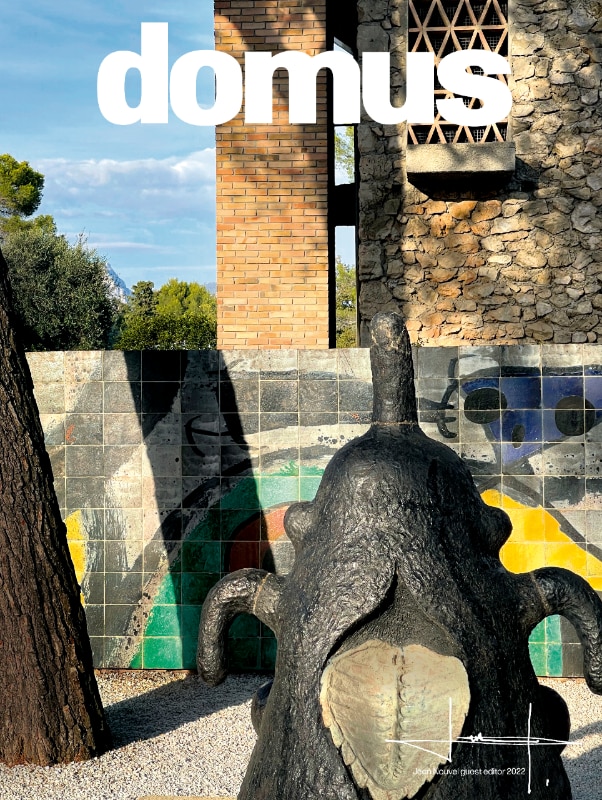The underlying theme that I have chosen for my guest editorship of Domus 2022 is character. With this in mind, it is my hope that Domus may crystallise its evocative power, expressing sensations, sensibilities, anomalies and exceptions through its choice of architecture or objects, and endeavouring to convey the genuine impressions experienced when faced with those chosen subjects. We are not sheriffs assigned to guarantee classical codes and orthodox visions that purport to be objective. Accepting subjectivity is the first step towards sensibility.
Making architecture is about defining a character. And yet, most early 21st century architecture is characterised by being uncharacterised. It is interchangeable. We have entered an era of automatic architecture. When drawing up plans for urban developments, still today the priority is to optimise the speed of execution... To save time for designers who no longer design anything. To satisfy entrepreneurs who always want to do the same thing, and to please developers who rake in profits without taking risks... These are all figures who have nothing to do with character. They have the blessing of the politicians of the moment, whose main concern is to be forgotten. Excuse the euphemism, but as you can see for yourselves, everything is working as intended!
The legitimate societal role of architecture, and therefore of the architect, is to give character to a place, to lend it depth, to imagine it, and to invent a life that brings out the spirit of a place.
On a hill in Saint-Paul de Vence covered in cluster pines, a rare event took place 60 years ago that established the unexpected and unpredictable permanence of a joyful, insolent, mocking and playful art. That rare opportunity was provided by an encounter between the art lover Aimé Maeght, the Catalan architect and follower of Le Corbusier Josep Lluís Sert, and the Catalan artist and eternal child Joan Miró, who spent his life cheerfully loving life and savouring every moment, entertaining and being entertained, moving us and delighting us – yes, enjoyment can be contagious! Robert Filliou was right about the function of art: art is the only thing that can make life more interesting than art. Architecture is an art, and it must nurture and accommodate other forms of art to make our lives more beautiful.
Miró’s Labyrinth is a work to experience physically, a profoundly evocative place in osmosis with the trees, the horizon, the sea and the sky. It interferes with spontaneity, with the spontaneities that render the spirit of a moment eternal... the artist’s spirit that gives shape to characters. Since then, we have seen how globalised urbanism has become more deadly than ever for the human dimension: character is linked to place, expressing its geography and history. It is linked to memory and above all to a sincere desire to convey the pleasure of being there and not elsewhere.
Yes, that’s how architecture begins! Architects must not be prevented from doing architecture by constraints and rules. The legitimate societal role of architecture, and therefore of the architect, is to give character to a place, to lend it depth, to imagine it, and to invent a life that brings out the spirit of a place.
Miró’s Labyrinth is a work to experience physically, a profoundly evocative place in osmosis with the trees, the horizon, the sea and the sky.
To do so, we need architects with a strong character and an iron will. Architecture is not something we can make by ourselves. Architects are artists who must work alongside other artists on all levels of a project, from a house to a street or square, and from a private garden to a park. Unfortunately, such collaboration is rarely encouraged these days.
Domus is a magazine about contemporary architectural creation. So why this return to the past? Forgive me, but I cannot help being struck by the ever-enduring relevance of awareness and of the profound understanding between patron, architect and artist. I firmly believe that nothing could be more topical in the architectural panorama today than this example, which demonstrates that atomised art, in public spaces as in apartments, lacks the strength of being indissociable and conceptually premeditated that is capable of awakening the genius loci, the character and atmosphere of a place.
This is precisely why, when leaving Miró’s Labyrinth in 1964, André Malraux surmised: “Here something may have occurred in the history of the spirit”.
Opening image: Jean Nouvel. Photo Giovanni Del Brenna


